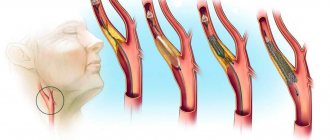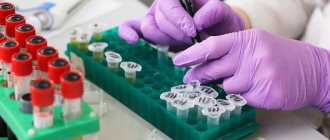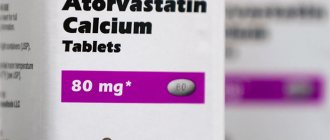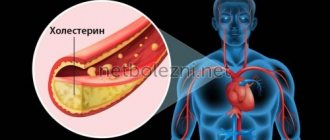What is cholesterol
To understand this issue in more detail, you should understand what cholesterol is and why the human body needs it.
Cholesterol is a substance without which the body cannot function normally. It performs a number of important functions:
- Contained in the membranes of all cells of the human body, which makes them more durable and resistant to external influences.
- Participates in the production of essential hormones, including sex hormones.
- Affects choleretic metabolism and fat absorption.
- Helps normalize the functioning of the nervous system, as it is contained in myelin cells that conduct nerve impulses.
Cholesterol is usually divided into “good” and “bad”. “Good” is produced by the human body itself, or more precisely by the liver, and makes up more than 80% of all cholesterol. It is very important for the functioning of all organs and cells. A person receives “bad” cholesterol from the outside, that is, through food.
There is an opinion that to lower blood cholesterol levels it is necessary to reduce the amount of animal fat consumed.
In other videos on Dr. Shishonin’s blog, you can learn more about this topic and find out why this statement is a myth leading to severe forms of atherosclerosis. Important:
Low cholesterol levels are worse than high cholesterol levels in the blood.
This may indicate a variety of biochemical problems.
Possible causes of decreased cholesterol levels
Fatty alcohol or cholesterol is another name for the well-known cholesterol. The mechanism for reducing its concentration in the body has been poorly studied, but based on the available data, the following conclusions can be drawn. Experts call the probable causes of the pathology:
- Severe liver diseases. It is this organ that synthesizes up to 80% of the total amount of cholesterol, so liver diseases lead to a drop in its level.
- Irrational diet. We are talking about ignoring foods containing fats and preferring foods with fast carbohydrates.
- Vitamin deficiencies. Deficiency of substances necessary for the body due to starvation, severe infectious diseases, anorexia.
- Prolonged state of stress. Adrenaline, produced during nervous overload, is an antagonist of fatty alcohols.
- Pathologies of the thyroid gland. For example, hyperthyroidism is accompanied by severe disruption of the production and balance of essential hormones. Changes in hormonal levels are another reason for the decrease in its concentration in the blood.
- Taking drugs that suppress the synthesis of fatty alcohols. Inadequate dosage of statins, fibrates, and nicotinic acid can lead to an excessive reduction.
In addition, prolonged febrile states caused by infectious diseases (tuberculosis, pneumonia) or injuries are recognized as provoking hypocholesterolemia. Unfavorable factors of occurrence also include anemia or hereditary abnormalities, often associated with liver dysfunction.
In women, changes in blood cholesterol concentrations often occur during pregnancy. Especially if it is complicated by a relapse of chronic diseases.
Reduced cholesterol levels
A decrease in cholesterol levels not only indicates internal problems of the body, but also increases the risk of developing various diseases several times. Among them are:
- stroke;
- liver cancer;
- emphysema and asthma;
- alcoholism and drug addiction;
- clinical depression.
There can be many reasons for low blood cholesterol, here are some of them:
- Limiting the consumption of foods containing animal fats. Dr. Shishonin in his blog dispels the myth that vegetarianism is a great way to lower cholesterol and become healthier. This diet can lead to metabolic disorders and abnormal cholesterol levels.
- Liver diseases. As mentioned above, the liver is involved in the production of cholesterol, which is so necessary for the functioning of all systems and organs. If there are problems with it, the balance is upset.
- Genetic predisposition.
- Poisoning.
- Anemia.
- Overactive thyroid gland and many others.
You can find out more information about this and many other important aspects of health related to blood pressure, osteochondrosis, atherosclerosis by becoming a member of the Club of Former Hypertensive Patients
.
Join our community, download gymnastics, which has already helped hundreds of thousands of people overcome blood pressure surges and hypertension. Get the most up-to-date and correct information, ask your questions to Dr. Shishonin and just communicate.
How much cholesterol should women and men have: norm by age
Cholesterol levels differ between men and women and vary depending on age. As you grow older, the lower limit gradually increases. Before the age of 50, men may have slightly higher rates, and after 50 they should be lower than women.
Norm of total cholesterol, mmol/l
| Age | Women | Men |
| 20–30 years | 3,16–5,75 | 3,16–6,32 |
| 30–40 years | 3,37–6,27 | 3,57–6,99 |
| 40–50 years | 3,81–6,86 | 3,91–7,15 |
| 50–60 years | 4,20–7,77 | 4,09–7,15 |
| 60–70 years | 4,45–7,85 | 4,12–7,10 |
| 71 years and older | 4,48–7,25 | 3,73–6,86 |
However, doctors believe that cholesterol levels above 6 mmol/l already pose a health risk, as they can cause atherosclerosis. Therefore, for convenience, you can remember the following numbers:
- normal cholesterol level – up to 5 mmol/l,
- moderately elevated cholesterol – 5–6 mmol/l,
- elevated – from 6 mmol/l or more,
- critically elevated cholesterol – 7.8 mmol/l.
Important: the information provided is for informational purposes only. The doctor must interpret the tests and make decisions about prescribing medications or any other therapy.
It all starts with damage to the inner lining of the vessel (endothelium). For example, due to exposure to bacteria or viruses. A barely noticeable chip appears on it. Cholesterol, combined with low-density lipoprotein, follows such a vessel, clings to the damaged area and remains there. This creates an obstacle for other similar LDL compounds, which easily lose lipids and leave them on the vessel wall. A small and fairly soft plaque appears.
Over time, it becomes overgrown with collagen, accumulates calcium and increasingly destroys the inner wall of the vessel, making it thin and brittle. An overgrown plaque narrows the cavity of the vessel and prevents blood from flowing freely through it, thereby interfering with the delivery of oxygen and other vital substances to tissues and organs, such as the heart or brain. Most often, atherosclerosis damages the coronary arteries directly connected to the heart. As a result, coronary disease and other cardiovascular diseases develop:
- coronary heart disease
- narrowing of the coronary artery, lack of oxygen in the heart muscle, disruption of its functioning; - hypertension
– high blood pressure, which causes stroke, heart attack and other complications; - stroke
- a violation of blood circulation in the brain due to damage to its blood vessels; - heart attack
– death of a section of the heart muscle due to loss of blood supply.
There is another risk. Atherosclerosis sometimes causes sudden death. The fact is that when blood pressure rises, blood penetrates into the plaque on the wall of the vessel and begins to clot. Coagulated blood forms a blood clot, which can partially or completely block the vessel. If the blood clot is large enough, it will sooner or later block a cardiac or pulmonary artery and may cause death.
Thus, increased cholesterol in combination with low-density lipoproteins (LDL) increases the risk of atherosclerosis, thrombosis, coronary artery disease, heart attack and other cardiovascular diseases. Cholesterol in high-density lipoprotein (HDL), in turn, plays a protective role and helps cleanse the body of excess lipid.
Symptoms and consequences
Not every disease actively manifests itself with symptoms. A person can live for a long time with low cholesterol levels in the blood and not even suspect it. Nevertheless, there are a number of signs that may indicate that, against the background of low cholesterol levels in the blood, a person develops pathologies and diseases:
- loss of appetite and its complete absence for no apparent reason;
- constant weakness;
- fatty stools;
- enlarged lymph nodes;
- mood swings;
- decreased sexual desire.
Low cholesterol levels can lead to serious diseases, including:
- deterioration of vascular elasticity and, as a result, hemorrhagic stroke;
- the development of obesity, since the metabolism of fat cells is disrupted and incoming fats cannot be absorbed normally;
- problems of the reproductive system, since cholesterol is involved in the synthesis of sex hormones;
- impaired body resistance to insulin and, as a result, diabetes mellitus;
- disorders of the nervous system, because with a lack of cholesterol, serotonin receptors cannot function normally. Because of this, anxiety, depression and even degradation develop.
What to do?
Since a person receives only 5-10% of the total cholesterol contained in the body from the outside, we can conclude that a low level indicates serious failures of internal metabolic processes in the body. There are situations when the patient takes certain drugs that reduce his levels. In other cases, the problem should be resolved immediately.
To improve your cholesterol levels, you first need to understand why your cholesterol levels have dropped. This can only be done by a competent specialist, so if the test shows low cholesterol in the blood, you should immediately go to the doctor.
It is impossible to give a general recommendation, since it is completely specific for each person. Low blood cholesterol levels indicate serious problems in the body.
Dr. Shishonin argues that if cholesterol levels drop, it is necessary to contact a competent specialist, otherwise there is a risk of seriously suffering from metabolic disorders.
How to take a blood cholesterol test correctly
It is recommended to donate blood for cholesterol at least once a year. Two weeks before the planned test, you should stick to your normal diet, not go on a diet, but also not abuse fatty foods. Avoid alcohol intake the day before.
The test is taken in the morning on an empty stomach - no less than 12 hours after eating. It is recommended to remain calm. It is better to come to the laboratory a little early in order to have the opportunity to sit in peace for 5–10 minutes and catch your breath.










